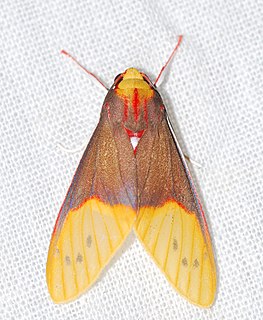Haemanota is a genus of moths in the family Erebidae. The genus was erected by George Hampson in 1901.
Zatrephes mirabilis is a Neotropical species of moths in the family Erebidae. It is found in French Guiana.
Nezula is a monotypic moth genus in the family Erebidae. Its only species, Nezula grisea, is found in French Guiana, Venezuela, Suriname, Panama, Upper Amazonas and Ecuador. Both the genus and species were first described by William Schaus in 1896.
Senecauxia is a monotypic moth genus in the family Erebidae. Its only species, Senecauxia coraliae, is found in French Guiana. Both the genus and the species were first described by Hervé de Toulgoët in 1989.
Eriostepta sanguinea is a moth of the family Erebidae. It was described by British entomologist George Hampson in 1905, originally under the genus Araeomolis; Hervé de Toulgoët transferred it to Eriostepta in 1993. It is found in French Guiana, Guyana, Peru, and the Brazilian state of Amazonas.

Evius albicoxae is a moth of the family Erebidae. It was described by William Schaus in 1905. It is found in French Guiana and Peru.

Evius hippia is a moth of the family Erebidae. It was described by Caspar Stoll in 1790. It is found in Mexico, Panama, Trinidad, French Guiana, Colombia, Suriname, Venezuela and Brazil.

Pseudepimolis incisa is a moth of the family Erebidae. It was described by Walter Rothschild in 1909. It is found in Costa Rica, French Guiana, Brazil, the upper Amazon region, Venezuela and Bolivia.
Glaucostola flavida is a moth of the family Erebidae first described by William Schaus in 1905. It is found in French Guiana, Guyana and Trinidad.

Glaucostola guttipalpis is a moth of the family Erebidae first described by Francis Walker in 1856. It is found in French Guiana, Guyana, Brazil, Ecuador and Costa Rica.
Haemanota chrysozona is a moth of the family Erebidae. It is found in French Guiana.
Hypercompe eridanus is a moth of the family Erebidae first described by Pieter Cramer in 1775. It is found in Colombia, Suriname and French Guiana.
Hypercompe guyanensis is a moth of the family Erebidae. It is found in French Guiana.
Hypidalia sanguirena is a moth of the subfamily Arctiinae first described by William Schaus in 1905. It is found in Brazil, French Guiana, Venezuela, Ecuador and Bolivia.

Idalus vitrea is a moth of the family Erebidae. It was described by Pieter Cramer in 1780. It is found in Mexico, Guatemala, Honduras, Costa Rica, Panama, Paraguay, Peru, French Guiana, Bolivia, Brazil, and Venezuela.
Neonerita fenestrata is a moth of the family Erebidae. It was first described by Walter Rothschild in 1910. It is found in Brazil and French Guiana.
Zatrephes toulgoetana is a moth of the family Erebidae. It was described by Michel Laguerre in 2005. It is found in French Guiana.
Tessella klagesi is a moth in the family Erebidae. It was described by Walter Rothschild in 1909. It is found in Brazil, French Guiana and Ecuador.
Trichromia coccineata is a moth in the subfamily Arctiinae. It was described by Rothschild in 1935. It is found in French Guiana, Suriname and Amazonas.

Trichromia gaudialis is a moth in the family Erebidae. It was described by William Schaus in 1905. It is found in French Guiana and Trinidad.





